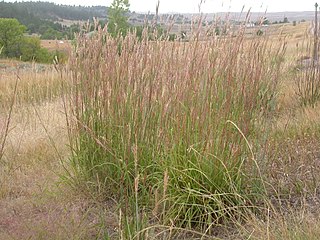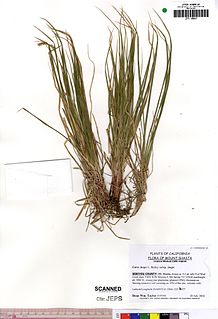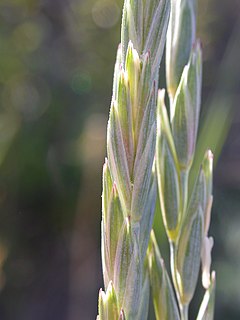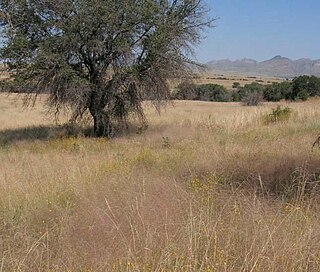| Calamagrostis montanensis | |
|---|---|
 | |
| Scientific classification | |
| Kingdom: | Plantae |
| (unranked): | Angiosperms |
| (unranked): | Monocots |
| (unranked): | Commelinids |
| Order: | Poales |
| Family: | Poaceae |
| Genus: | Calamagrostis |
| Species: | C. montanensis |
| Binomial name | |
| Calamagrostis montanensis Scribn. ex Vasey | |
Calamagrostis montanensis is a species of grass known by the common names plains reedgrass and prairie reedgrass. It is native to North America, where it is found across Canada from British Columbia to Manitoba and south to Colorado in the United States. [1]

Poaceae or Gramineae is a large and nearly ubiquitous family of monocotyledonous flowering plants known as grasses, commonly referred to collectively as grass. Poaceae includes the cereal grasses, bamboos and the grasses of natural grassland and cultivated lawns and pasture. Grasses have stems that are hollow except at the nodes and narrow alternate leaves borne in two ranks. The lower part of each leaf encloses the stem, forming a leaf-sheath. With around 780 genera and around 12,000 species, Poaceae are the fifth-largest plant family, following the Asteraceae, Orchidaceae, Fabaceae and Rubiaceae.

British Columbia is the westernmost province of Canada, located between the Pacific Ocean and the Rocky Mountains. With an estimated population of 5.016 million as of 2018, it is Canada's third-most populous province.

Manitoba is a province at the longitudinal centre of Canada. It is often considered one of the three prairie provinces and is Canada's fifth-most populous province with its estimated 1.3 million people. Manitoba covers 649,950 square kilometres (250,900 sq mi) with a widely varied landscape, stretching from the northern oceanic coastline to the southern border with the United States. The province is bordered by the provinces of Ontario to the east and Saskatchewan to the west, the territories of Nunavut to the north, and Northwest Territories to the northwest, and the U.S. states of North Dakota and Minnesota to the south.
This plant is a perennial grass growing a single stem, not forming a tuft or clump. It grows up to 60 centimeters tall. It has a network of thin rhizomes and roots that hold the soil, forming sod. The roots have been observed to penetrate over a meter deep in the soil. The stiff, rolled leaves are mostly located around the base of the stem and reach up to 15 centimeters long by just a few millimeters wide. The inflorescence is a narrow panicle up to 10 centimeters long. The spikelet contains one flower. [2] The plant reproduces vegetatively by sprouting from its rhizome and sexually by its wind-dispersed seed. [1]

A perennial plant or simply perennial is a plant that lives more than two years. The term is often used to differentiate a plant from shorter-lived annuals and biennials. The term is also widely used to distinguish plants with little or no woody growth from trees and shrubs, which are also technically perennials.

In botany and dendrology, a rhizome is a modified subterranean plant stem that sends out roots and shoots from its nodes. Rhizomes are also called creeping rootstalks or just rootstalks. Rhizomes develop from axillary buds and grow horizontally. The rhizome also retains the ability to allow new shoots to grow upwards.
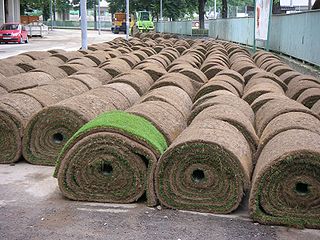
Sod or turf is grass and the part of the soil beneath it held together by its roots or another piece of thin material.
This grass occurs in a number of habitat types, including temperate coniferous forest, sagebrush, shrubsteppe, and several types of prairie and grassland. It is a dominant grass species in several regions in the Great Basin and Great Plains. It tolerates cold winters and hot summers. It is common in disturbed habitat. It grows in all stages of ecological succession and is a climax species in some regions, such as the Canadian mixed-grass prairie and the mountains and foothills of Montana. [1]

Temperate coniferous forest is a terrestrial habitat type defined by the World Wide Fund for Nature. Temperate coniferous forests are found predominantly in areas with warm summers and cool winters, and vary in their kinds of plant life. In some, needleleaf trees dominate, while others are home primarily to broadleaf evergreen trees or a mix of both tree types. A separate habitat type, the tropical coniferous forests, occurs in more tropical climates.

Sagebrush is the common name of several woody and herbaceus species of plants in the genus Artemisia. The best known sagebrush is the shrub Artemisia tridentata. Sagebrushes are native to the North American west.

Prairies are ecosystems considered part of the temperate grasslands, savannas, and shrublands biome by ecologists, based on similar temperate climates, moderate rainfall, and a composition of grasses, herbs, and shrubs, rather than trees, as the dominant vegetation type. Temperate grassland regions include the Pampas of Argentina, Brazil and Uruguay, and the steppe of Ukraine, Russia and Kazakhstan. Lands typically referred to as "prairie" tend to be in North America. The term encompasses the area referred to as the Interior Lowlands of Canada, the United States, and Mexico, which includes all of the Great Plains as well as the wetter, hillier land to the east.
This is the only Calamagrostis that provides forage for grazing livestock on the northern Great Plains. It is consumed by cattle and horses, and less often by sheep. It is not a favorite forage plant for livestock because its leaves are coarse in texture. [1]
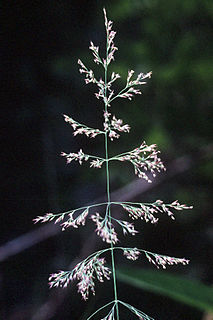
Calamagrostis is a genus in the grass family Poaceae, with about 260 species that occur mainly in temperate regions of the globe. Towards equatorial latitudes, species of Calamagrostis generally occur at higher elevations. These tufted perennials usually have hairless narrow leaves. The ligules are usually blunt. The inflorescence forms a panicle. Some may be reed-like.
Forage is a plant material eaten by grazing livestock. Historically, the term forage has meant only plants eaten by the animals directly as pasture, crop residue, or immature cereal crops, but it is also used more loosely to include similar plants cut for fodder and carried to the animals, especially as hay or silage. The term forage fish refers to small schooling fish that are preyed on by larger aquatic animals.

